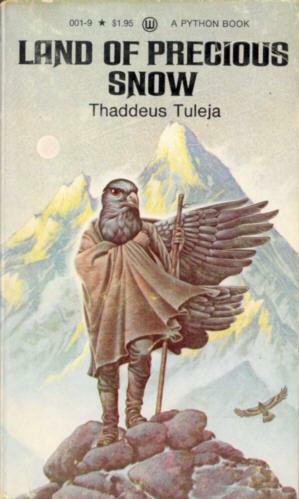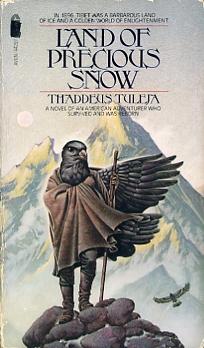By William Wetherall
First posted 5 May 2010
Last updated 7 May 2010
Thaddeus Tuleja The novel consists of ten titled chapters set between November 1896 and September 1897, though not strictly in this order. The story opens in February 1897, with "Sugar Duke" William P. Detroit mounting an expedition to serach for his friend John Pierre Dey and Dey's 20-year-old son Jethro. The previous year, the elder Dey, a dealer in precious stones, and taken his son to the Far East to purchase some jewels, and they have not been heard of since. Jey Dey, a junior at Harvard, was supposed to have gone only as far as Calcutta then returned alone to the United States for the fall 1896 term. His father would go on to Tibet. Detroit is not happy about the situation, and is especially irked by the need to go to Tibet (Avon edition, page 18).
Urging Detroit to let his son Bill pursue the whereabouts of the Deys is his daughter Jennifer, Bill's younger sister, who is "unofficially betrothed" to Jed Dey. Jed had been corresponding with her and last wrote from Calcutta in saying "No luck here. North to Tibet." The senior Dey spoke "a grating patois of Provincial French, mountain slang, and -- if legend be true -- an Indian tongue from somewhere just east of the Rockies." The particulars of Jed Dey's life do not include knowledge of his mother, who died shortly after his birth in the gold fields. Presumably "it was from her that the father and son had acquired their facility in heathen tongues." The father took his son with him as he circled the globe, spending time in Central America, "then by steamer to China, India, and Japan, where the former prospector augmented his knowledge of the precious things on earch by purchasing, ultimately, twelve trunks full of jade, amber, turquoise, beryl, and silver" -- paid for with gold.
Detroit had warned his friend Dey about Harvard, which "had educated presidents" but now -- ruled by "progressive forces . . . under the control of Charles Eliot Norton" -- "was producing the likes of the Negro radical W.E.B. DuBois, the Jew freethinker Santayana, and Jed's own eccentric tutor, the ranting oddfellow Yarrowville." But Dey had ignored Detroit's offer to "write a recommendation to his own alma mater, where education still came from the great books of the West" (pages 26-27).
Chapter 1 -- "The Avenue (February 1897)" -- continues in this highly humorous vein of social satire that is perhaps best understood from the perspective of the 1970s, the decade Land of Precious Snow was published, at the height of post-bohemian Hippydom. The second chapter, "Snowblind (November 1896)", switches the "he" protagonist from the senior Detroit to the junior Dey (page 35)
As fun as parts of the story were, I have to admit I had to force myself to endure long stretches that perhaps I would have understood better had I been less alienated when I was going to college in the 1960s and 1970s, and particated in the near fanatical quest for meaning in anything and everything "mystical" -- or had I been literally or metaphorically smoking something. Promotional burbsThe Avon edition has the following blurbs. Front cover
Back cover
TeaserThe first leaf of the book has this teaser.
Thaddeus TulejaAccording to some sources, which I am unable to confirm, Thaddeus Tuleja was the pen behind the name Marshall Macao, who wrote the seven titles of the Chong Fei K'ing Kung-Fu series published by Venus Freeway Press in New York and London in the early 1970s, shortly before the appearance of Land of Precious Snow. 1. Son of the Flying Tiger (1973) 2. Return of the Opium Wars (1973) 3. The Rape of Sun Lee Fong (1973) 4. The Kak-Abdullah Conspiracy (1973) 5. Red Plague in Bolivia (1974) 6. New York Necromancy (1974) 7. Mark of the Vulture (1974) Chong Fei K'ing, the Son of The Flying Tiger, was orphaned in China, where he was trained from childhood in the martial arts. Equating "Marshall Macao" with "Thaddeus Tuleja" does not, however, shed much light on the identity of "Thaddeus Tuleja" much less his object in writing Land of Precious Snow -- in which Jed Dey, a survivor of an adventure gone wrong in the Himalayas, finds his Shangri-La in the embrace of Tibetan Buddhism. Thaddeus V. Tuleja, of St. Peter's College, Jersey City, New Jersey, was a professor of history. A captain in the US Navy Reserve after service during World War II, he held the Navel War College Ernest J. King Chair of Maritime History from 1970-1971. This Tad Tuleja was the author of a number of well-known tomes on military history, including Climax at Midway (1960). Thaddeus F. Tuleja is the author of books like these. That's a new name to me. Some of Goulart's pseudonyms are: - CHAD CALHOUN - R.T. EDWARDS - IAN R. JAMIESON - JOSEPH KAINS - JILL KEARNY - HOWARD LEE - ZEKE MASTERS - MARSHALL MACAO - KENNETH ROBESON - FRANK S. SHAWN - JOSEPH SILVA - CON STEFFANSON The Sloane books are by Michel Parry as Steve Lee. 'Kenneth Robeson' was the magazine house name used mainly by Lester Dent for the Doc Savage Magazine novels of the 1930s (a few other authors used the name, but he wrote most of the stories). Howard Lee is the name that appears on the covers of the first 4 original Kung Fu novelisations published by Warner between 1973-74, to tie-in with the David Carradine TV series, which, as far as I know, started the Kung Fu craze over here. Re: K'ing Kung Fu - Marshall Macao ≪ Reply #22 on: Mar 27th, 2008, 07:09am ≫ Hate to resurrect an old thread, but just to set the record straight, I searched for a while to try and find out who the actual author/author's of the K'ing Kung Fu series were and Ron Goulart's name came up. But I wrote to Ron and he had this to say: "You are on the wrong track. I've been credited with this series on a couple of Net bibliographies, but it ain't so. What I did write back then was two of the 4 Warner paperbacks based on the Carradine Kung Fu television series. Barry Malzberg wrote the 1st one and, I think, Lou Cameron wrote the other one." |

